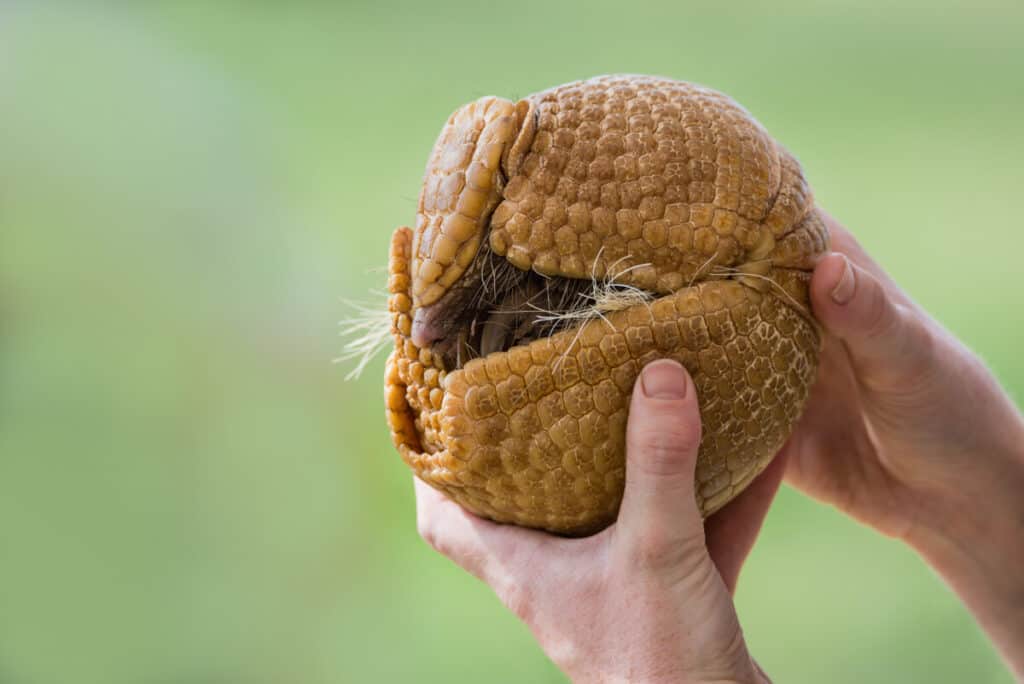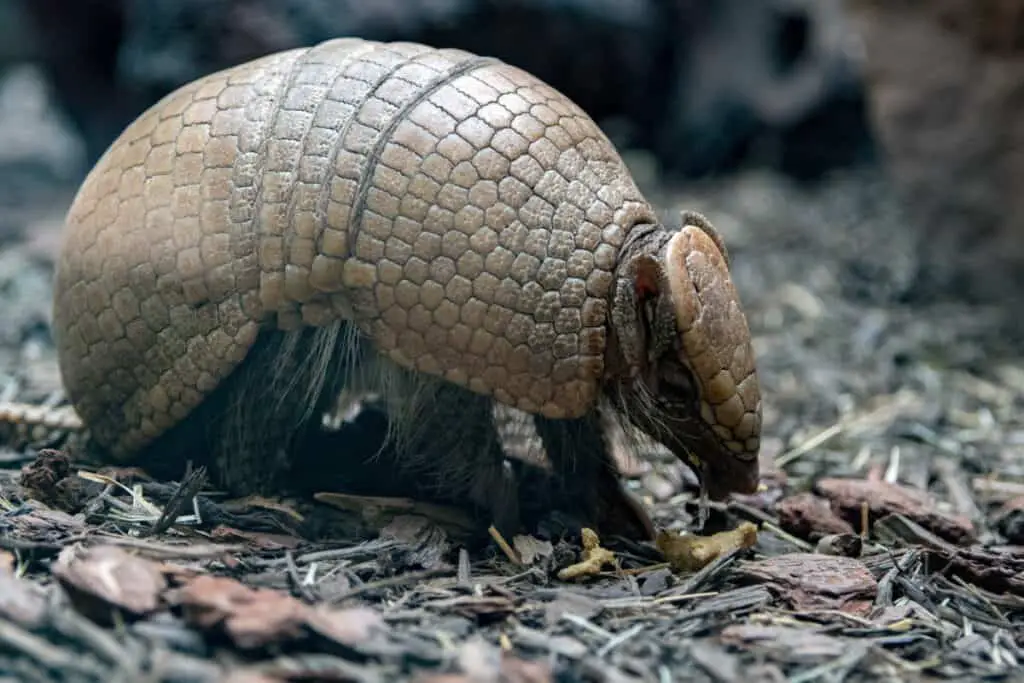Armadillos are small, burrowing mammals native to the Americas. Their diverse range of characteristics make them a fascinating species to study and observe.
This article will examine armadillo characteristics in depth, including their physical appearance, behavior patterns, and diet.
Armadillos have a distinctive armored shell that acts as protection against predators. It is made up of overlapping plates called scutes which can be either soft or hard depending on the species. They also tend to have long claws adapted for digging and thick fur that helps maintain body temperature while they sleep underground during the day. Additionally, some species have unique features such as an ability to roll into a ball when threatened or swim underwater using their back legs like paddles.
Behaviorally, armadillos are mainly nocturnal animals who spend most of their time searching for food at night. They typically feed on insects but also consume fruits, roots and other plant material depending on availability in their habitats.

Physical Appearance
Armadillos are small mammals characterized by their protective armor. They have a distinct physical appearance, consisting of a thick and leathery shell that covers the upper part of the body and head as well as shorter bands on the legs and tail.
The fur covering their bodies is typically gray or brown in color, although some species may be yellowish or white. Armadillos also have short snouts with long whiskers, which help them locate food sources in dark environments such as underground burrows.
The shape of armadillo’s bodies is unique due to its heavily armored backside. It consists of overlapping plates made up of bone-like material called osteoderms, giving it an oblong shape when viewed from above.
They also have powerful claws which they use for digging into soil or leaves while searching for insects and other prey items. Their strong hindquarters enable them to jump quickly away from potential predators if necessary.
Adaptations For Defense
The physical appearance of the armadillo is impressive, but its adaptations for defense are nothing short of extraordinary.
To begin with, these small creatures have a variety of burrowing behaviors that allow them to find shelter and hide from predators. When faced with danger, they can dig up to 18 inches deep in just 5 minutes!
Additionally, they often live together in groups where they rely on their numbers as protection against larger animals or birds of prey.
Moreover, when cornered by a predator they use another unique adaptation- rolling into an armored ball which makes it nearly impossible for any animal or bird to get at them. This amazing maneuver has given rise to the popular phrase ‘playing possum’ amongst people who study armadillos.
In addition, some species even employ tail-lashing tactics to ward off attackers and create confusion among potential enemies.
Finally, their tough shells provide yet another layer of defense against sharp teeth and claws allowing them to survive even in the harshest environments.
From using camouflage techniques like digging shallow holes quickly to forming large groups for safety or simply curling up into a tight ball, the armadillo exhibits remarkable defensive behavior -allowing it thrive despite living in such dangerous conditions.
From sophisticated burrowing behaviors to group dynamics rarely seen elsewhere in nature–the armadillo’s array of defenses truly deserves admiration!
Unique Features
The unique features of the armadillo are numerous. Their social behavior is quite different from other mammals and their mating rituals often present a variety of behaviors that can be observed in the wild.
| Characteristic | Description | Evidence |
|---|---|---|
| Social Behavior | Armadillos have highly developed communication skills, including vocalizations, body language, and scent marking. They may also live in groups up to ten individuals depending on species. | Field observations show that they interact with one another by snorting, grunting, and even hissing when disturbed or threatened. Studies further suggest that armadillos use visual cues for communicating emotions such as fear and curiosity. |
| Mating Rituals | Armadillos engage in elaborate courtship displays before mating occurs. Males will groom females prior to copulation and some species perform “dance-like” movements during courtship. Females typically go into heat once every two years after which males compete for mates through competitive displays. | Research conducted by experts shows that male armadillos exhibit a wide range of behaviors during courtship such as fighting over females and using tactile signals like sniffing, licking, chasing, mounting, and biting each other while competing for mates. |
These characteristics indicate an overall complexity within the armadillo family not found in many other mammalian species. The combination of physical attributes and social behavior make this animal truly remarkable to observe and study in the wild.
Nocturnal Behavior
Armadillos possess a unique nocturnal behavior that sets them apart from most other animals. Studies show that nearly 80% of armadillo activity occurs at night, when they are more active and adept in their search for food and social interaction.
Armadillos communicate with one another primarily through scent marking, touch communication, and vocalizations such as chirps or barking. In addition to these methods of communication, armadillos also demonstrate behavioral patterns related to mating rituals and territorial disputes.
During the dry season especially, male armadillos will mark territories with urine and secretions from glands located around the face and chest area, while females are observed engaging in aggressive behaviors to ward off intruders or competing suitors.
Social interaction among members of the same species is essential for survival; it allows individuals to acquire information regarding resources available during times of scarcity and can help prevent unnecessary conflicts with predators.
Dietary Habits
Armadillos are foraging animals, which means that they spend a large portion of their time in search of food. Their diet primarily consists of insects as well as small vertebrates and fruits. To ensure maximum efficiency during the foraging process, armadillos have developed certain adaptations such as claws that allow them to more easily uncover prey items and powerful senses of smell to detect potential sources of nutrition.
The digestive processes of armadillos are also incredibly efficient due to anatomical modifications like an elongated stomach with multiple chambers and specialized microorganisms present within the gastrointestinal tract. These features enable armadillos to extract nutrients from their food quickly and effectively while limiting energy expenditure. Additionally, the presence of these microbes allows them to better break down plant material than other similarly-sized mammals with shorter digestive tracts.
As a result, armadillos not only survive but thrive on a variety of diets across many different ecosystems around the world.
Habitat And Range
Armadillos are well adapted to their environment and have a wide natural range. They inhabit both dry, arid regions as well as humid tropical forests. Their preferred habitats include grasslands and scrubland, with some species also found in desert environments.
The armadillo is an accomplished digger and can use its powerful claws for burrowing into the ground or breaking apart logs in search of food such as insects, worms, frogs and other small animals that form part of its diet. Armadillos will often forage at night when it is cooler, particularly during summer months when temperatures can become extremely high.
During these times they may take refuge from extreme heat by sheltering underground in their burrows which can be up to 2 metres deep.
Foraging habits:
- Nocturnal activity
- Diet includes insects, worms, frogs and other small animals
Burrowing behavior:
- Powerful claws used for digging
- Digging depths reach up to 2 meters
These characteristics make them resilient to changing climates and unpredictable weather conditions allowing them to survive in many different parts of the world. The ability to adapt quickly has enabled them to colonize new areas over time ensuring their continued survival even amid human development.

Conclusion
Armadillos are unique creatures with a variety of physical adaptations and behaviors. Their armored shells, sharp claws, and powerful jaws make them well-equipped to protect themselves from predators.
Furthermore, their nocturnal lifestyle allows them to remain active during the night while avoiding daylight activity. Armadillos also have an omnivorous diet that includes both plants and animals so that they can take advantage of food sources in their habitat.
Additionally, armadillos range from southern United States all the way through Central America into northern Argentina. All these features work together to create a resilient species capable of enduring across multiple environments.
From this research it is clear that armadillo characteristics allow them to thrive despite challenging conditions in the wild.

